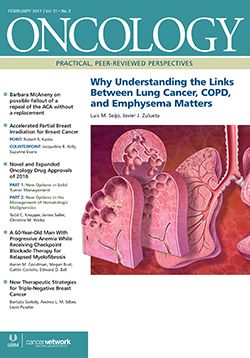Accelerated Partial Breast Irradiation for Breast Cancer: An Innovative Option for Selected Early-Stage Cancers
To paraphrase a deep philosophical question: if an important, long-awaited phase III prospective randomized trial from Europe is published and no one pays attention, does it make a sound?
Oncology (Williston Park). 31(2):104-106.

Robert R. Kuske, MD

To paraphrase a deep philosophical question: if an important, long-awaited phase III prospective randomized trial from Europe is published[1] and no one pays attention, does it make a sound?
For many years, the leaders in accelerated partial breast irradiation (APBI) research have heard from skeptics: “Despite the large number of single-institution studies, large registry reports, and a mature prospective phase II Radiation Therapy Oncology Group (RTOG) trial, we really need to see a head-to-head comparison of the standard 6 weeks of whole-breast irradiation (WBI) vs 4 or 5 days of partial breast irradiation before we can embrace APBI as an acceptable treatment option for selected breast cancers.” Although the data are robust and the results of the European randomized trial of APBI are positive, the “sound” does not seem to be reverberating through radiation oncology centers in the United States-and the impact is muffled.
A Look at the Evidence
What does it take for an innovative treatment to be accepted as a new standard of care? Can you imagine the uproar in the radiation scientific community if a similar randomized trial demonstrated positive outcomes for intensity-modulated radiotherapy? Sentinel node mapping for breast cancer was adopted as a standard with fewer supporting data than APBI has now. Prostate brachytherapy became a viable and accepted treatment option without any randomized data, as did laparoscopic cholecystectomy and indeed many therapies now considered as “standard of care.”
The evolution of the scientific evidence for APBI is a model for how medicine should advance. Twenty-five years ago, the first patient was treated at the Ochsner Clinic in New Orleans with wide-volume brachytherapy using modern techniques and a target volume defined as 2 cm beyond the lumpectomy cavity. Since then, significant advances have occurred in the technology, methods of delivery, and data accumulation.
The original hypothesis-that selected breast cancers can be successfully treated by hypofractionated twice-daily targeted brachytherapy or external beam radiotherapy to the tissue at highest risk for microscopic tumor cells after breast-conserving surgery-was supported by pathology studies that showed a decreasing malignant cell gradient as the distance from the lumpectomy cavity edge increased. Under this hypothesis, covering all breast tissue in remote quadrants of the breast is unnecessary for selected breast cancers. This concept was also supported by randomized clinical trials of lumpectomy alone vs lumpectomy and WBI, which showed no difference in the subsequent rate of “elsewhere recurrence,” defined as a new tumor in a different quadrant of the breast or at least 4 cm away.
The Ochsner Clinic and the William Beaumont Hospital in Michigan both executed prospective phase II trials with matched-pair analyses that demonstrated no significant difference between 4- or 5-day interstitial brachytherapy APBI and 6-week WBI, with long-term follow-up.[2,3]
The RTOG conducted the phase II multi-institutional clinical trial 95-17.[4] This prospective trial took 2 years to develop, because new quality assurance measures had to be created and selection criteria were extensively debated in committees. Eligible participants included women of all ages with invasive nonlobular carcinomas who had pathologic tumors of ≤ 3 cm that were excised with margins exhibiting no ink on tumor, and who were node-negative or had 1 to 3 positive nodes without extracapsular extension. Grade 3 and estrogen receptor (ER)-negative tumors were allowed. Twenty percent of patients had positive nodes, and human epidermal growth factor receptor 2 status was not assessed at that time. One hundred patients signed informed consent, but one patient was deemed ineligible because she had sentinel node mapping instead of axillary dissection. All patients were treated with low- (45 Gy in 3 to 5 days) or high-dose-rate (34 Gy in 10 twice-daily fractions, separated by at least 6 hours) interstitial brachytherapy. With 12.5 years’ median follow-up, the ipsilateral breast tumor recurrence (IBTR) rate was only 6.2% at 10 years. Note that the patients in this study were not the more favorable subsets that have been included in many subsequent studies.
In 2002, the US Food and Drug Administration approved the MammoSite balloon catheter, which greatly simplified brachytherapy by creating a single-entry device that surgeons could place using local anesthesia in an office setting. Radiation oncologists would then deliver 34 Gy in 10 fractions over 5 days using a high-dose-rate iridium-192 robot. Later, the multichannel Contura balloon catheter and the multistrut SAVI (strut-adjusted volume implant) applicator were added to the armamentarium, and APBI is now used to treat approximately 15% of early-stage breast cancers in the United States. Each of these devices has been studied in large registry trials, with favorable tumor control and low toxicity profiles. More than 40 single-institution reports have been published.
The PROMIS registry study includes more than 1,500 patients treated with interstitial brachytherapy APBI at 6 institutions. With a median follow-up of over 6 years, the 7-year actuarial IBTR rate is 6% overall and 5% for ductal carcinoma in situ (DCIS).[5]
Despite the large number of publications, the scientific community awaited level 1 evidence. The first randomized prospective trial came from Hungary.[6] The small number of participants hindered statistical strength, but equivalent tumor control was reported, with a trend to better cosmetic outcomes with interstitial brachytherapy APBI.
The National Surgical Adjuvant Breast and Bowel Project (NSABP) B39/RTOG 0413 phase III trial randomized 4,214 women to 5 days of APBI or 5 to 6 weeks of WBI.[7] In the APBI arm, three techniques were allowed: interstitial brachytherapy, single-entry brachytherapy, and three-dimensional conformal external beam APBI. More than 70% of patients received the last treatment option. At over 8 years’ median follow-up, the number of events in the two arms has not met statistical criteria for release of the data.
Single-dose intraoperative lumpectomy cavity irradiation has been studied in two randomized trials. The Italian electron beam intraoperative radiotherapy (ELIOT) phase III trial demonstrated a higher recurrence rate in the electron beam arm but has been criticized for lacking clearly defined target volume and quality assurance measures.[8] The UK-based Targeted Intra-Operative Radiotherapy (TARGiT) trial used soft 50-kV x-rays and also showed a higher recurrence rate in the intraoperative radiation therapy (IORT) arm.[9] This study has been criticized for delivering a tumoricidal dose to only 2 mm of tissue beyond the lumpectomy edge. A thin layer of blood, air, or seroma potentially blocks any significant dose to breast tissue at risk for recurrence.
The results of the Groupe Européen de Curiethérapie–European Society for Radiotherapy and Oncology (GEC-ESTRO) phase III trial were presented by Professor Strnad at a plenary American Society for Radiation Oncology (ASTRO) session and immediately published in the Lancet.[1] Interstitial brachytherapy was directly compared with conventional WBI. At 5 years, this study demonstrated the noninferiority of APBI by this method. A trend toward lower toxicity in the APBI arm was noted.
Thus, over a period of 25 years, brachytherapy APBI has been one of the most studied treatments in medical history. The hypothesis that only the affected part of the breast, with a clearly defined margin, needs to be treated in selected breast cancers has been supported by many single-institution and registry trials, a national prospective phase II RTOG clinical trial, and now the phase III GEC-ESTRO trial, as well as the positive but less powerful original Hungarian randomized trial.
How Much Evidence Is Necessary?
What does it take for a treatment to be accepted as a standard of care?[10] How much evidence is necessary? Is it acceptable to extrapolate from the rich and plentiful data supporting interstitial brachytherapy to three-dimensional conformal external beam APBI, single-entry devices, or IORT? With a skill-dependent procedure such as interstitial brachytherapy, what credentialing is necessary before it may be performed at various medical institutions around the United States or the world?
These are difficult questions to answer. Brachytherapy APBI now has level 1 evidence supporting it, which complements 25 years of research by numerous institutions and cooperative groups worldwide. There is enough evidence at this point to add interstitial brachytherapy as an option for the treatment of selected breast cancers.
The definition of “selected” would be the topic of another article, but most investigators include women older than age 50 with DCIS or invasive breast cancers of ≤ 3 cm who are node-negative. One particularly risky group, according to the PROMIS data, consists of women younger than age 50 who are ER-negative. Since the NSABP B39/RTOG 0413 randomized trial has a substantial number of high-risk women enrolled, answers should be forthcoming.
Financial Disclosure:Dr. Kuske has an unrestricted educational grant from Elekta for the PROMIS registry trial and minor stock options in Cianna Medical.
References:
1. Strnad V, Ott OJ, Hildebrandt G, et al. 5-year results of accelerated partial breast irradiation using sole interstitial multicatheter brachytherapy versus whole-breast irradiation with boost after breast-conserving surgery for low-risk invasive and in-situ carcinoma of the female breast: a randomised, phase 3, non-inferiority trial. Lancet. 2016;387:229-38.
2. King TA, Bolton JS, Kuske RR, et al. Long-term results of wide-field brachytherapy as the sole method of radiation therapy after segmental mastectomy for T(is,1,2) breast cancer. Am J Surg. 2000;180:299-304.
3. Shah C, Antonucci JV, Wilkinson JB, et al. Twelve-year clinical outcomes and patterns of failure with accelerated partial breast irradiation versus whole-breast irradiation: results of a matched-pair analysis. Radiother Oncol. 2011;100:210-4.
4. Arthur DW, Winter K, Kuske RR, et al. A phase II trial of brachytherapy alone after lumpectomy for select breast cancer: tumor control and survival outcomes of RTOG 95-17. Int J Radiat Oncol Biol Phys. 2008;72:467-73.
5. Kamrava M, Kuske R, Anderson B, et al. Outcomes of breast cancer patients treated with accelerated partial breast irradiation via multicatheter interstitial brachytherapy: the pooled registry of multicatheter interstitial sites (PROMIS) experience. Ann Surg Oncol. 2015;22(suppl 3):abstr 404.
6. Polgár C, Fodor J, Major T, et al. Breast-conserving therapy with partial or whole breast irradiation: ten-year results of the Budapest randomized trial. Radiother Oncol. 2013;108:197-202.
7. Wolmark N, Curran WJ, Vicini F, et al. Response to “Unacceptable cosmesis in a protocol investigating intensity-modulated radiotherapy with active breathing control for accelerated partial-breast irradiation” (Int J Radiat Oncol Biol Phys 2010;76:71-78) and “Toxicity of three-dimensional conformal radiotherapy for accelerated partial breast irradiation” (Int J Radiat Oncol Biol Phys 2009;75:1290-1296). Int J Radiat Oncol Biol Phys. 2010;77:317; author reply 318.
8. Veronesi U, Orecchia R, Maisonneuve P, et al. Intraoperative radiotherapy versus external radiotherapy for early breast cancer (ELIOT): a randomised controlled equivalence trial. Lancet Oncol. 2013;14:1269-77.
9. Vaidya JS, Wenz F, Bulsara M, et al; on behalf of the TARGIT trialists’ group. Risk-adapted targeted intraoperative radiotherapy versus whole-breast radiotherapy for breast cancer: 5-year results for local control and overall survival from the TARGIT-A randomised trial. Lancet. 2014;383:603-13.
10. Kuske RR, Young SS. Breast brachytherapy versus whole-breast irradiation: reported differences may be statistically significant but clinically trivial. Int J Radiat Oncol Biol Phys. 2014;88:266-8.
